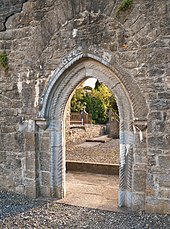Ballinrobe Monastery
The Ballinrobe Monastery ( English Ballinrobe Priory ) in Ballinrobe ( Irish Baile an Róba ) was founded around 1312 as a priory of the Augustinian brothers consecrated to the Virgin Mary in the Archdiocese of Tuam in Ireland and was the first house of the order in Connacht . The monastery was closed around 1584 in the course of the Reformation, but the Augustinian Brothers were present again for some time after the rebellion of 1641 .
history
It was probably founded by Elizabeth de Clare , granddaughter of King Edward I of England , who married John de Burgo in 1308 , who received the area around Lough Mask including Ballinrobe as a fief from his father and Earl of Ulster , Richard de Burgo . Elizabeth and her family were already in contact with the order in England, so it was natural to found an Augustinian monastery in Ballinrobe. But only a quarter of a century later the monastery witnessed the dwindling English domination of Connacht. In 1338 Edmund de Burgo, also a son of Richard de Burgos, was captured in the monastery by his cousin, Edmund Albanach de Burgo, who had joined the Irish, and taken to an island in Lough Mask. Although negotiations were under way for a release, mediated by the Archbishop of Tuam, Máel Sechlainn Mac Áeda, the prisoner was placed in a sack of weights and sunk in the lake. Since then the monastery has been associated with the Irish branch of the family. Since the buildings were already in need of repair in the 15th century, an indulgence was granted in 1400 and 1431 .
A brother named Richard Madden from Ardnaree Monastery received a dispensation from the requirements of religious life in March 1423 . A year later, however, the prior, Bernard de Burgo, was ordered to revoke Madden's abused privileges. Martin suspects that incidents like this facilitated the establishment of the observance movement in Connacht by the Banada Monastery, founded in 1423 .
A report by the Prior General from 1542 shows that initially seven Augustinian houses continued to exist despite the Reformation . This also included a ballin robe. An English government report from 1574 stated that Ballinrobe belonged to either the rebels or the brothers and that the crown had no access. In 1584, however, the monastery was closed and an appraisal was carried out, which found about 30 acres of land. However, after the rebellion of 1641, the brothers managed to return to the monastery.
The ruins of the monastery underwent restoration work from 1990-1994, carried out by the Lough Mask & Lough Carra Tourist Development Association and the Foras Áiseanna Saothair (Irish Employment Agency). During this work, in particular the east window with Gothic tracery and the west portal were restored. The British Museum has a silver seal of the monastery with the inscriptions SIGULLUM CONVENT ORDIS: ERMITT.S.AUG.J. and BALENROB , which frame a representation of the Sacred Heart .
literature
- Francis X. Martin: Irish Augustinian Reform Movement in the Fifteenth Century . In: JA Watt, JB Morrall, FX Martin (Eds.): Medieval Studies: Presented to Aubrey Gwynn, SJ . Colm O Lochlainn, Dublin 1961, p. 230-264 .
- Aubrey Gwynn , R. Neville Hadcock: Medieval Religious Houses in Ireland . Longman, London 1970, ISBN 0-582-11229-X .
Web links
Remarks
- ↑ Gwynn, pp. 295-296.
- ^ Gwynn, p. 296.
- ^ Martin, p. 235.
- ^ Gwynn, p. 296.
- ↑ Martin, pp. 235-236.
- ^ Martin, p. 263.
- ^ Gwynn, p. 296.
- ↑ Information boards on site.
Coordinates: 53 ° 37 ′ 34.8 " N , 9 ° 13 ′ 14.5" W.

